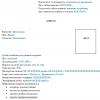Bramitob - instructions for use. Tobramycin eye drops instruction Side effects and precautions
Registration number. LSR - 003882 / 08-210508
Tradename.
Bramitob
International non-proprietary name.
tobramycin
Dosage form.
Solution for inhalation.
Compound.
1 ml of the drug contains:
Active substance:
Tobramycin 75 mg
Excipients:
Sodium chloride, sodium hydroxide, sulfuric acid, water for injection.
Description.
Light yellow to yellow transparent solution in a hermetically sealed plastic ampoule.
Pharmacotherapeutic group.
The antibiotic is an aminoglycoside.
ATX code.
J01GB01
Pharmacological properties.
Tobramycin is an aminoglycoside antibiotic produced by microorganisms of the genus Streptomycestenebrarius.
The main mechanism of its action is a violation of protein synthesis, which leads to a change in the permeability of the cell membrane, increasing damage to the cell membrane and subsequent cell death. Tobramycin has a bactericidal effect at concentrations equal to or slightly higher than the inhibitory concentration.
Tobramycin is active mainly against gram-negative aerobic microorganisms, having low activity against anaerobic microorganisms and most gram-positive bacteria.
Tobramycin is more active than gentamicin against Pseudomonas aeruginosa and some strains of proteus; about 50% of strains Pseudomonas aeruginosa, resistant to gentamicin, are susceptible to tobramycin.
When administered by inhalation, the minimum inhibitory concentration (MIC) of tobramycin in the sputum of patients with cystic fibrosis is significantly higher than when administered parenterally.
Pharmacokinetics.
After inhalation of 300 mg of BRAMITOB by cystic fibrosis patients after 30 minutes, a maximum concentration of about 1289 μg / g is reached in sputum, while in plasma the maximum concentration of 758 ng / ml is reached after about 1.5 hours. The half-life is 4.5 hours.
Excretion of the drug absorbed into the blood occurs through the kidneys by glomerular filtration.
Indications.
Treating infections respiratory tract caused by Pseudomonasaeruginosa in patients with cystic fibrosis.
Contraindications
- hypersensitivity to the drug;
- childhood up to 6 years old;
Carefully.
Ischemic disease heart, chronic heart failure in the stage of decompensation, diabetes, pregnancy. Renal failure, hearing impairment, vestibular dysfunction, or neuromuscular disorders such as parkinsonism or other conditions characterized by muscle weakness, including myasthenia gravis, acute hemoptysis.
Pregnancy and lactation.
The use of the drug during pregnancy is possible only if the expected benefit to the mother exceeds possible risk for the fetus.
If it is necessary to use the drug during lactation, it is necessary to stop breastfeeding.
Method of application anddose.
Inhalation using a nebulizer. Adults and children over 6 years old:
- one ampoule (300 mg) twice a day (morning and evening) for 28 days. The interval between inhalations should be about 12 hours, but not less than 6 hours.
After using BRAMITOB for 28 days, it is necessary to take a break for 28 days, after which, continue therapy for the next 28 days.
The dosage regimen does not take into account body weight. All patients should be prescribed one ampoule of Bramitoba (300 mg tobramycin) twice a day.
Directions for correct use.
- Bend the detachable ampoule from the strip in both directions.
- Separate the ampoule from the strip, first upper part, then the middle one.
- Open the ampoule by turning its upper part relative to the body in the direction of the arrow.
- Pressing moderately on the walls, pour the medication into the glass neck of the nebulizer.
The content of one ampoule (300 mg), poured into a nebulizer, is administered by inhalation in 10-15 minutes using a reusable PARI LC PLUS nebulizer with compressors, which, when connected to a PARI LC Plus nebulizer, provide a delivery of 4-6 l / min and / or back pressure equal to 110-217 kPa.
Inhalation of Bramitoba is carried out in the sitting or standing position of the patient, with normal breathing through the mouthpiece of the nebulizer. A nose clip can help the patient breathe through the mouth.
Instructions for cleaning and disinfecting the nebulizer.
After the end of the inhalation procedure, the nebulizer should be disassembled, its individual parts (except for the tube) should be thoroughly rinsed with hot water and liquid detergent, rinsed and wiped dry with a clean dry cloth that does not leave fibers. For regular disinfection of the nebulizer, it is recommended to lower its individual parts (except for the tube), cleaned in accordance with the above instructions, in a solution consisting of one part 9% acetic acid and three parts hot water for one hour, then rinse with hot water and wipe dry clean cloth.
After the completion of disinfection, the used solution should be discarded immediately.
Alternatively, disinfection can be carried out by boiling for 10 minutes.
Side effect.
Rarely |
||
From the musculoskeletal system
- very rare: back pain.
On the part of the blood and lymphatic system:
- very rare: lymphadenopathy;
From the senses:
- rarely: ringing in the ears, hearing loss;
- very rare: vestibular and labyrinth disorders, ear pain.
From the central and peripheral nervous system:
- rarely: headache, dizziness;
- very rare: drowsiness.
From the side gastrointestinal tract:
- rarely: nausea, ulcerative stomatitis, vomiting, change in taste;
- very rare: diarrhea.
From the respiratory system:
- infrequently: change in voice, shortness of breath, increased cough, pharyngitis;
- rarely: bronchospasm, increased sputum production, hemoptysis, deterioration of lung function, laryngitis, nose bleed, rhinitis.
- very rare: hyperventilation, hypoxia, sinusitis.
Local reactions:
- very rare: fungal infections, oral candidiasis.
- rarely: skin rash, anorexia, chest pain, asthenia, fever.
- very rare: abdominal pain and discomfort.
Overdose.
An overdose symptom may be a pronounced hoarseness of the voice.
In case of accidental ingestion of BRAMITOBA inside toxic effect unlikely because tobramycin is poorly absorbed from the gastrointestinal tract.
In case of accident intravenous administration BRAMITOBA may develop symptoms and signs of tobramycin overdose, such as dizziness, hearing loss, tinnitus, vertigo, respiratory distress syndrome, neuromuscular blockade, and impaired renal function.
In the event of signs of an overdose, BRAMITOB should be immediately canceled and a study of renal function indicators should be carried out. To control overdose, the determination of serum tobramycin concentrations may be helpful.
Interaction with other medicinal products.
No significant drug interactions BRAMITOBA at joint application with mucolytics, β 2 -adrenomimetics, inhaled corticosteroids and other oral and parenteral antibiotics with antipseudomonal activity.
Avoid the simultaneous or sequential use of inhaled tobramycin and other potentially nephro- or ototoxic drugs... Some diuretics can increase the toxicity of aminoglycosides by altering serum and tissue concentrations of the antibiotic. Inhaled tobramycin should not be given concomitantly with ethacrynic acid, furosemide, urea, or mannitol.
Aminoglycoside toxicity may increase with parenteral administration the following drugs: amphotericin B, cephalothin, cyclosporin, tacrolimus, polymyxins (risk of increased nephrotoxicity), platinum preparations (risk of increased nephrotoxicity and ototoxicity), as well as cholinesterase and botulinum toxin inhibitors (neuromuscular effects).
special instructions.
Treatment with BRAMITOB should be prescribed by a doctor who has experience in the management of patients with cystic fibrosis. The duration of the course of treatment is determined by the doctor, based on clinical picture diseases. In the case of a confirmed deterioration of pulmonary function, an additional antibiotic therapy.
With inhalation of BRAMITOB, bronchospasm may develop. The first dose of BRAMITOB should be administered under the supervision of a physician, prescribing a bronchodilator before inhalation, if it is already included in the patient's treatment regimen. FEV1 (forced expiratory volume) should be measured before and after the procedure. If signs of iatrogenic bronchospasm appear in a patient who is not receiving a bronchodilator, the drug must be repeated separately using a bronchodilator. The appearance of bronchospasm while using a bronchodilator may indicate an allergic reaction. If an allergic reaction is suspected, the use of BRAMITOB should be discontinued. To relieve bronchospasm, appropriate pathogenetic therapy should be carried out.
During treatment with BRAMITOB, the patient should continue with standard physiotherapy. chest... The use of bronchodilators should be continued until clinical indications... When using several methods of treating respiratory disorders, the following order is recommended: bronchodilator, respiratory physiotherapy, other inhaled drugs, and finally Bramitob.
Bramitob should not be mixed with other inhaled medicines.
BRAMITOB should be used with great caution in patients with parkinsonism or other conditions characterized by muscle weakness, including myasthenia gravis, since aminoglycosides can increase muscle weakness due to a possible curariform effect on neuromuscular conduction.
The drug should be used with caution in patients with proven or suspected renal failure, provided that serum tobramycin concentrations are monitored.
It is necessary to periodically assess the indicators of renal function (the level of urea and creatinine at least once during 6 courses of therapy with BRAMITOB). If signs of nephrotoxicity appear, treatment with tobramycin should be interrupted until the minimum concentration of the drug in serum decreases to less than 2 μg / ml. Then treatment with BRAMITOB can be resumed for medical reasons. Patients concurrently receiving parenteral therapy with other aminoglycosides should be closely monitored for the potential for cumulative toxicity.
When using aminoglycosides, ototoxicity may develop (hypoacusia, systemic and non-systemic dizziness, ataxia).
The physician should take into account the possibility that aminoglycosides may have vestibular and cochlear toxicity and should evaluate hearing function during BRAMITOBA therapy. Patients who have previously taken aminoglycosides for a long time are recommended to undergo audiometric tests before starting therapy with BRAMITOB. When treating vertigo, it should be taken into account that it is a manifestation of ototoxicity. If dizziness or hearing loss occurs during therapy with BRAMITOB, an audiological examination is necessary.
With inhalation, a cough reflex may appear. The use of inhaled tobramycin in patients with acute hemoptysis should be carried out only if the benefits of treatment outweigh the risk of provoking further bleeding.
In some patients treated with tobramycin, there is an increase in the MIC of aminoglycosides in relation to the studied isolated strains of P. aeruginosa. The development of resistance of P. aeruginosa strains to intravenous tobramycin is possible.
Release form.
Solution for inhalation 300 mg / 4 ml.
4 ml in a hermetically sealed plastic ampoule. A strip of 4 ampoules is placed in an aluminum strip. 4, 7 or 14 strips with instructions for use are placed in a cardboard box.
Termsuitability.
2 years.
Do not use after the date printed on the package.
Storage conditions.
At a temperature of + 2-8 ° C, in the original packaging to protect from light, away from heating appliances. Do not freeze. Keep out of the reach of children.
Conditions for dispensing from pharmacies.
On prescription.
Manufacturer.
Chiesi Farmacetutici S.p.A.
Via Palermo 26 / A
Parma, Italy.
Produced by:
Holopack Verpackungstechnik GmbH
Bahnhofstrabe 74429 Sulzbach-Laufen, Germany.
Chiesi Pharmaceuticals S.P.A.,
26 / A, VIA PALERMO,
PARMA, Italy
Golopak Ferpakungstekhnik GmbH
Bahnhofstrasse 74429 Sulzbach-Laufen, Germany.
Consumer claims should be sent to:
Chiesi Pharmaceuticals LLC
125190, Moscow, st. Usievich, 20, building 1
Tobramycin eye drops- This is a unique drug that is a bactericidal antibiotic, which belongs to the group of aminoglycosides. At the moment, we can say with confidence that the drug will act on gram-negative and gram-positive microorganisms.
Eye drops Tobramycin - bactericidal antibiotic
If you plan to use these drops, then remember that they can be prescribed for meningitis, peritonitis, pneumonia, and sepsis.
pharmachologic effect
At the moment, these drops are released in the form of a solution and a special powder for preparing a solution for injection. After using drops of Tobramycin, protein synthesis in bacteria will be disrupted. If you plan to use these drops in maximum doses, then remember that in this case the cytoplasmic layers of microorganisms may be damaged.
Tobramycin eye drops the instruction informs that at the moment these drops will have wide range activity. This remedy will be especially effective for combating staphylococci. Many experts claim that the drug can also disrupt the vital activity of microorganisms that will be resistant to gentamicin.
If you plan to use a special powder for injection, then remember that its effect will come in 30-60 minutes. If children suffer from renal infiltration, then the drug will accumulate in the body more. The elimination of the drug from the body will take place with the help of the kidneys.
Indications
The instructions contain information that this antibiotic will effective remedy for the treatment of a variety of infections that are triggered by the following infections:
- Joint infections.
- Bones.
- Biliary tract.
Also, thanks to this medicine, you can inhibit the vital activity of the Pseudomonas aeruginosa. Patients with cystic fibrosis can often use Tobramycin for inhalation. At the moment, this drug is used in ophthalmology. Tobramycin drops can also be prescribed for blepharitis, keratitis and conjunctivitis.
Contraindications
Drops and Tobramycin solution will not need to be used for hearing impairment and renal failure. Also, this antibiotic will be completely contraindicated in case of sensitivity to aminoglycosides. If you are currently in a position, then only a doctor should prescribe this drug. With extreme caution, these drops must also be prescribed for:
- Botulism.
- Dehydration.
- Renal failure.
Mode of application
At the moment, the instructions contain information that Tobramycin can be used intramuscularly, intravenously, inhaled and topically.
To prepare an intramuscular solution, Tobramycin powder will need to be dissolved in 3 or 5 ml of novocaine.
 Bottle eye drops Tobramycin
Bottle eye drops Tobramycin For intravenous infection, the powder will need to be dissolved in 100-200 ml of 5% glucose solution or 0.9% sodium chloride solution. In most cases, the dosage will depend on your body weight. To do this, you need to see a doctor who will prescribe everything. The duration of treatment will also be discussed on a case-by-case basis. For inflammatory eye diseases, Tobramycin drops can be used topically.
Side effects
While using Tobramycin eye drops, you may experience the following side effects:
- Loss of appetite, vomiting and diarrhea.
- Drowsiness and dizziness.
- Shortness of breath, pharyngitis, bronchispasm, laryngitis and sinusitis.
- Ear pain.
- Fever, asthenia, headache and allergic manifestations.
Storage conditions
At the moment, the instructions contain information that the drops will need to be stored in a place protected from sunlight. The storage temperature of these drops should be 6-8 degrees. From the moment of release, the drops will last for three years.
Analogs Tobramycin
If necessary, you can also use analogs:
- Nebtsin.
- Bramitob.
- Tobriss.
During their use, you need to consult with specialists. We hope you find this information useful.
326 10.10.2019 4 minutesTobramycin eye drops are classified as aminoglycosides. And its action is aimed at eliminating destruction metabolic processes squirrel. The drug is able to stop the growth of microbial cells.
This is unique medicine, which is marketed as a bactericidal antibiotic. And at the moment it is often used in the treatment of pneumonia, meningitis or sepsis.
Description of the drug Tobramycin (tobramycin) and release form
Form of release of tobramycin (tobramycin) in glass vials. It comes in the form of a transparent solution, as well as in the form of a powder for further preparation of injections. According to the drug, it also has antibacterial properties.
The drug is sold in special sealed packages with instructions and detailed dosage.
Antibiotic composition
tobramycin eye drops
In 1 ml. eye drops contain tobramycin sulfate 3mg. As well as additional substances: benzalkonium chloride, sodium sulfate, boric acid, sulfuric acid, sodium hydroxide, purified water. used for various infectious diseases.
Pharmacological properties, trade name

The drug has a wide spectrum of action, has a bactericidal effect, and the action is aimed at disrupting protein synthesis. the instructions for ocoferon eye drops can be found in ours.
A positive effect was noted during the treatment of diseases caused by bacteria that are resistant to gentamicin, neomycin. A pronounced effect in the treatment of infections, especially those associated with Pseudomonas aeruginosa. Other anti-inflammatory and antibacterial eye drops are available for review.
Antibiotic eye drops work very well against staphylococci. The drug does not penetrate well through the intact cornea. The drug can eliminate the infection in a short time, relieve redness and swelling. Whether okomistin helps with conjunctivitis can be read.
Indications for the use of eye drops
The drug Tobramycin can be prescribed to eliminate superficial eye infections, and is also used in postoperative period for prevention and quick healing. Reviews for Luxfen eye drops can be found.
It is not recommended to use the drug for children under 1 year of age.
Children after 1 year old can use eye drops in the same way as adults. The dosage and duration of use is determined by the doctor.
Mode of application

 for diseases caused by a virus, 1-2 drops are prescribed in the infected eye, no more than 4 times a day.
for diseases caused by a virus, 1-2 drops are prescribed in the infected eye, no more than 4 times a day.
If the infection is more complex, it is worth instilling 2 drops of the drug in both eyes, every hour until there is clear relief. improves vision.
Side effects and precautions
In some cases, after applying the drops, you may experience side effects, such as: itching, redness, severe tearing, swelling of the eyelids. Such symptoms occur in 3% of patients. As indicated in, the drug is prescribed for various inflammatory processes.
The drug under this trade name causes these symptoms due to its toxicity to the surface of the cornea. In this case, punctate keratitis may occur. Reviews of stillavite drops can be read on ours.
In those who took Tobramycin systemically, the following side effects were found:
- Kidney damage.
- Hearing impairment.
- Deterioration of the nervous system.
 To avoid side effects, it is worth observing the following precautionary methods:
To avoid side effects, it is worth observing the following precautionary methods:
1. Do not use eye drops for a long time.
2. Constantly adjust the treatment regimen with your doctor.
3.Strictly observe the dosage and time of use.
4. Do not use the drug for pregnant women.
5. An increase in sensitivity is possible by combining the use of the drug with iminoglycosides.
Tobradex is an ophthalmic drug combined action, which has become widespread in the treatment various diseases organs of vision. It is characterized by a pronounced anti-inflammatory and bactericidal effect. The drug has actively established itself in pediatrics due to its gentle effect.
Tobradex is sold as a medicated solution for the eyes. Tobramycin acts as an active component. In 1 ml of solution, it is contained in an amount of 3 mg. Additional components include:
- benzalkonium chloride,
- water for injection,
- hypromellose,
- disodium edetat,
- sodium chloride,
- hydrochloric acid.
Sell drops in a plastic bottle. Its capacity is 5 ml. Equipped with dropper and dispenser. The container is placed in a cardboard box. Storage of the drug should take place in a dark place, and the air temperature should not exceed 30 degrees. Do not store drops in the refrigerator. After purchase, they must be used within 2 years. If the bottle has already been opened, then use the medicinal solution within 30 days.
Main component medication - an antibiotic with a wide range of effects. It belongs to the minoglycosides. In low concentration, it has a bacteriostatic effect, disrupts the process of protein production. At a high concentration, it has a bactericidal effect, since the death of a pathogenic cell is observed.
The presented medication is active against:
- staphylococcus aureus;
- Pseudomonas aeruginosa;
- klebsiella pneumonia;
- colibacillus;
- mirabilis prosthesis.
When applied topically active ingredient the drug is absorbed in low concentration.
Active compound - tobramycin is poorly absorbed through the cornea. If you exceed the frequency of use of the medicinal solution, this can lead to an increase in the concentration of the main component in intraocular fluid.
Assign antibacterial drops may in the presence of the following pathological changes:
- blepharitis;
- blepharoconjunctivitis;
- dacryocystitis and meibomitis;
- conjunctivitis, keratoconjunctivitis;
- keratitis;
- iridocyclitis.
Instructions for use
Medicinal solution must be dripped into the conjunctival sac. In order for the drug to have the maximum effect, it is worth adhering to the following plan:
- Wash hands thoroughly with soap and water.
- Hold the bottle with the drug in your palms for 2 minutes and shake to form an equilibrium suspension.
- Lie on the sofa, tilt your head back and pull the lower eyelid.
- Introduce the required number of drops into the conjunctival sac.
- Close your eyes and press on inner corner with your finger.
- When using drops, make sure that the tip of the bottle does not touch the mucous membrane and eyelashes.
- After use, close the bottle with a lid.
On the video - how to apply drops for adults:
The duration of the therapeutic course can be determined by the attending physician based on the diagnosis and the course of the pathology.
Use drops of Tobradex for adults, 1-2 drops into the affected organ of vision with an interval of 4-6 hours. Tobradex eye drops should not be used in children under 1 year old. Older patients are prescribed 1 drop in each eye 3 times a day.
You can buy Tobradex drops at any pharmacy without a doctor's prescription. Their cost is 201 rubles. But why a burning sensation may occur during instillation, this information will help to understand.
Analogs
When there is no way to use Tobradex for the treatment of eye diseases (allergy, lack of a drug in pharmacies), the doctor prescribes the following analogs:

Reviews
- Tamara, 45 years old: “The doctor prescribed Tobradex drops for me to treat inflammation of the eyelids. The course of my illness was extremely difficult. Unpleasant symptoms in the form of itching, burning, pain bothered me greatly. At first, I could not even think that this drug is so effective. The doctor prescribed me to drip 4 times a day for 7 days. I want to note that there are no side effects, but the positive dynamics was traced already on the second day. The symptoms became less pronounced, so I could go about my business. "
- Andrey, 36 years old: “I used Tobradex in the treatment of conjunctivitis. The fact is that this pathology is in my chronic form... I can't get rid of it completely, but it is possible to muffle the symptoms in the stage of remission. And helps me with this this drug... It is worth dripping 2 drops into each eye after 4 hours. On the 2nd day, the intervals between instillations should be 5-6 hours. The duration of my therapy was 10 days. I want to note that you need to drip 2 eyes, regardless of whether he is affected or not. Another advantage of the drug is the preservation of visual acuity after instillation. I've experienced this before when I used antibacterial ointments. "
Tobradex is an effective antibacterial drug presented in the form of eye drops. It is effective against many bacteria. Therapeutic effect observed already on the 2nd day after use. If after 5 days there is no positive dynamics, then stop treatment with this drug.
okulist.online
Tobramycin
(2S, 3R, 4S, 5S, 6R) -4-amino-2 - ([(1S, 2S, 3R, 4S, 6R) -4,6-diamino-3 - ([(2R, 3R, 5S, 6R ) -3-amino-6- (aminomethyl) -5-hydroxyoxan-2-yl] oxy) -2-hydroxycyclohexyl] oxy) -6- (hydroxymethyl) oxane-3,5-diol
Chemical properties
This substance belongs to the group of broad-spectrum aminoglycoside antibiotics. The compound is a waste product of the actinomycete Streptomyces tenebrarius.
Molecular weight of the substance = 467.5 grams per mole. The product dissolves well in water, poorly in ethyl alcohol, almost insoluble in ether and chloroform. In preparations, it is most often in the form of Tobramycin Sulfate, molecular mass sulfate = 1425 g per mole.
The tool is produced in the form of injection solutions of various concentrations; sterile powder for preparation of solutions; eye ointment 0.3%; solution for inhalation administration.
pharmachologic effect
Bactericidal, antibacterial.
Pharmacodynamics and pharmacokinetics
When using low concentrations of the agent, it has a bacteriostatic effect, in high concentrations it is bactericidal.
The substance blocks the normal synthesis of the ribosome subunit and disrupts the synthesis of white molecules. Further, if the concentration of the drug is high enough, the agent leads to disruption of the function of the cytoplasmic membrane, leading to the death of microbes.
Tobramycin acts on gram-negative and gram-positive bacteria: Escherichia coli, Proteus (almost all strains), Klebsiella, Serratia spp., Enterobacter aerogenes, Salmonella, Shigella, Providencia spp., Citrobacter spp., Haemophilus aegyptius, Haemophilus influenzae, Moraxella lacunata, Herellea vaginacola, Neisseria gonorrhoeae and some strains of Neisseria spp., Morganella morganii, Acinetobacter calcoaceticus; Enterococcus spp., Staphylococcus (most strains), Streptococcus (beta-hemolytic strains, Streptococcus pneumoniae, non-hemolytic strains).
The antibiotic has also been shown to be more effective in treating diseases caused by bacteria resistant to gentamicin or neomycin. The effect of the substance is more pronounced in the treatment of infections associated with Pseudomonas aeruginosa.
The drug is ineffective against various strains of group D.
Unlike intramuscular administration, when taken orally, the drug is poorly absorbed by the gastrointestinal tract. The agent reaches its maximum concentration after 30 minutes - 1.5 hours.
After a single intramuscular injection at a dosage of 1 μg per kg of patient weight, an equilibrium concentration of 4 μg per ml of blood is reached and lasts for 8 hours. Intravenous administration provides similar concentrations.
The substance hardly binds to blood plasma proteins and does not accumulate. The compound is found in sputum, abscess contents, synovial fluid. The drug does not cross the blood-brain barrier, but it crosses the placenta. Tobramycin is not metabolized. The substance is excreted through the kidneys using glomerular filtration. In a day, only 7% of the agent is present in the blood plasma and biological fluids. The half-life is 120 minutes.
In patients with impaired renal function and newborns, the pharmacokinetic parameters may differ slightly; the drug can be detected in the body for a longer period of time.
With dialysis, depending on the intensity and type of procedure, 25 to 70% of the drug can be removed.
When used topically in the composition of eye drops, the substance is not subjected to systemic absorption.
Indications for use
Chemical compound is part of solutions for intramuscular and intravenous administration:
- for the treatment of infectious diseases caused by microorganisms sensitive to the action of an antibiotic (biliary tract, joints, bones, central nervous system, abdomen, respiratory organs, skin, soft tissue, bile and urinary tract);
- after surgical interventions for the prevention or treatment of various inflammatory processes;
- with sepsis.
Tobramycin for the eyes, as part of drops and gels, is used for bacterial infections eyes: blepharitis, keratoconjunctivitis, keratitis, conjunctivitis, blepharoconjunctivitis, iridocyclitis.
Inhalation with Tobramycin is prescribed:
- for the treatment of respiratory tract infections caused by Pseudomonas aeruginosa;
- children from 6 years old with cystic fibrosis.
Contraindications
The medicine is not prescribed:
- with hypersensitivity to this antibiotic or a group of aminoglycosides;
- patients with renal insufficiency;
- with neuritis auditory nerve;
- pregnant women;
- in case of disturbances in the work of the brain caused by insufficient function of 8 pairs of cranial nerves.
The drug is used with caution:
Side effects
With systemic use, the following may appear adverse reactions:
- diarrhea, abnormal liver function, increased levels of liver enzymes or bilirubin;
- vomiting, nausea, polyuria, thirst, oliguria, proteinuria, increased levels of nitrogen in urea and creatinine, frequent or rare urination, dizziness;
- proteinuria, disorders of tubular secretion;
- anemia, leukocytosis, thrombocytopenia, leukopenia, granulocytopenia;
- damage to the vestibular apparatus and hearing, deafness, vertigo, tinnitus;
- headaches, drowsiness, convulsions, movement orientation disorders;
- paresthesia, hypocalcemia, sodium and magnesium deficiency in the blood;
- rashes and itching on the skin, hyperemia, fever, eosinophilia, Quincke's edema, other allergic reactions.
After inhalation, the likelihood of developing:
- ulcerative lesions of the oral cavity, fungal infections;
- shortness of breath, bronchospasm, nosebleeds;
- runny nose, voice changes, cough, pharyngitis, laryngitis;
- sinusitis, pulmonary hyperventilation, asthma, hypoxia.
When using the product in ophthalmic practice local reactions appear:
- itching, swelling, and redness of the eyelids;
- burning and pain during and after the instillation or application of the ointment;
- blurred vision.
Tobramycin, application instruction (Way and dosage)
Depending on the dosage form, disease and age, use different treatment regimens and dosages.
Intravenous and intramuscular administration
As a rule, the drug is administered by drip, in the form of an infusion. Before use, the solution for injection is diluted in an isotonic solution of sodium chloride or glucose. The duration of the procedure is from 20 minutes to an hour.
Before intramuscular administration, the drug is dissolved in a 0.5% solution of procaine or in water.
The dosage is different - depending on the location of the infection and the type of pathogen.
On average, the daily dosage for an adult is calculated at 2-3 mg per kg of body weight. Injections are made 3 times a day.
For children from 2 months, dosage adjustment is necessary. Typically, 6 to 7.5 mg of the agent is used per kg of the child's weight. The frequency of introduction is the same as for adults.
Also, the drug is prescribed in the form of inhalation. Follow your doctor's instructions.
Instructions for eye drops Tobramycin and ointment
With an infectious process moderate instill 1-2 drops into the affected eye (conjunctival sac), 3-4 times a day, every 4 hours.
If a severe infectious process has developed, then it is shown to use eye drops every hour - 30 minutes. After reducing inflammation, they switch to the normal regimen of taking the drug.
Eye ointment is placed behind the affected eyelid, 2-3 times a day. According to indications, the frequency of use of the drug can be increased up to 4 times a day. Then they switch to the normal reception mode.
The duration of treatment depends on its effectiveness.
Overdose
In case of an overdose, it develops renal failure, disorders of the vestibular apparatus and hearing, neuromuscular blockade, respiratory paralysis.
It is important for the patient to provide ventilation and oxygenation, hydration, normal urination, the level of creatinine and antibiotic in the blood should be monitored, and hemodialysis can be performed.
Interaction
Furosemide and ethacrynic acid, when combined with a substance, lead to an increase in the ototoxicity of drugs.
Solution for parenteral use should not be mixed in a dropper or syringe with other medicines.
With the combined use of Tobramycin with aminoglycosides, cephalosporins and polypeptide antibiotics the load on the kidneys increases.
The agent enhances the neurotoxicity of vancomycin.
Tobramycin, when combined with muscle relaxants, in particular tubocurarine, enhances their muscle-relaxing effect.
Terms of sale
A prescription is required.
Storage conditions
It is necessary to store the drug in accordance with the recommendations on the package, they differ depending on the dosage form.
Best before date
The solution for injection and infusion is stored for 2 years.
Shelf life for eye drops and capsules for inhalation is 3 years.
Once opened, the eye drops can be stored at low temperatures for up to 1 month.
special instructions
If the patient has previously experienced hypersensitivity reactions to the aminoglycoside group, then the likelihood of developing allergic reactions to Tobramycin is high.
Reversible or complete deafness due to drug treatment may appear after the end of treatment. During therapy, the agent is recommended to observe general condition the patient, kidney function, levels of calcium, creatinine, protein in urine, sodium and magnesium in blood plasma, conduct audiometric tests.
Sometimes at special groups patients require dosage adjustment (pregnant women, with peritonitis and burns, persons with high cardiac output or the speed of the renal glomeruli).
It should be remembered that prolonged use of the substance leads to the development of superinfections, most often mycoses.
It is recommended to take a 5-minute break between the instillation of this agent and any other drug in the form of eye drops.
Elderly
During pregnancy and lactation
The use of Tobramycin in pregnant women is permissible in extreme cases when there is a serious threat to the life of the mother.
The use of this drug in pregnant women can cause complete deafness in the fetus, the substance accumulates in the kidneys.
If there is a need to take the drug during lactation, then feeding should be stopped.
Preparations that contain (Analogues)
Matching ATX level 4 code:Trade names Tobramycin: Tobrex, Bramitob, Dilaterol, Tobi, Tobrom, Brulamycin, Tobropt, Nebtsin, Tobrazon, Dilaterol, Toby Podhaler, Tobramycin-Gobbi, Tobriss, Tobrosopt.
Reviews about Tobramycin
Reviews on the use of the antibiotic are good, the drug is quite effective, serious side reactions are rare.
Some reviews about the drug:
- “… During the game, my daughter injured her eye, fell on the toy. It turned out that nothing really terrible had happened, they prescribed eye drops with an antibiotic. After each instillation, the daughter was capricious and cried, apparently tingling from the drops. The medicine was good, it helped, there were no complications, no discharge, no pus ”;
- “… Throughout the entire course of treatment with Tobramycin, after the injections, I felt a little dizzy and had no appetite. However, these symptoms did not bother me much. The main thing is that I pierced the whole course and was cured ”;
- “… I had conjunctivitis. I suffered for a long time, tried to heal folk remedies... The doctor prescribed this antibiotic. I was very happy when the relief came after the first application. She cured conjunctivitis completely. "
Tobramycin price where to buy
The price of Tobrex eye drops, 0.3% is about 180-193 rubles per bottle, with a capacity of 5 ml.
NOTE! Information about active ingredients on the site is a reference and summarizing, collected from publicly available sources and cannot serve as a basis for making a decision on the use of these substances in the course of treatment. Before using the substance Tobramycin, be sure to consult with your doctor.
medside.ru
Eye drops Tobramycin
Tobramycin eye drops is a unique drug that is a bactericidal antibiotic that belongs to the aminoglycoside group. At the moment, we can say with confidence that the drug will act on gram-negative and gram-positive microorganisms.
 Eye drops Tobramycin - bactericidal antibiotic
Eye drops Tobramycin - bactericidal antibiotic If you plan to use these drops, then remember that they can be prescribed for meningitis, peritonitis, pneumonia, and sepsis.
pharmachologic effect
At the moment, these drops are released in the form of a solution and a special powder for preparing a solution for injection. After using drops of Tobramycin, protein synthesis in bacteria will be disrupted. If you plan to use these drops in maximum doses, then remember that in this case the cytoplasmic layers of microorganisms may be damaged.
Tobramycin eye drops, the instruction informs that at the moment these drops will have a wide spectrum of activity. This remedy will be especially effective for combating staphylococci. Many experts claim that the drug can also disrupt the vital activity of microorganisms that will be resistant to gentamicin.
If you plan to use a special powder for injection, then remember that its effect will come in 30-60 minutes. If children suffer from renal infiltration, then the drug will accumulate in the body more. The elimination of the drug from the body will take place with the help of the kidneys.
Indications
The instructions contain information that this antibiotic will be an effective treatment for a variety of infections that are triggered by the following infections:
- Joint infections.
- Bones.
- Biliary tract.
Also, thanks to this medicine, you can inhibit the vital activity of the Pseudomonas aeruginosa. Patients with cystic fibrosis can often use Tobramycin for inhalation. At the moment, this drug is used in ophthalmology. Tobramycin drops can also be prescribed for blepharitis, keratitis and conjunctivitis.
Contraindications
Drops and Tobramycin solution will not need to be used for hearing impairment and renal failure. Also, this antibiotic will be completely contraindicated in case of sensitivity to aminoglycosides. If you are currently in a position, then only a doctor should prescribe this drug. With extreme caution, these drops must also be prescribed for:
- Botulism.
- Dehydration.
- Renal failure.
Mode of application
At the moment, the instructions contain information that Tobramycin can be used intramuscularly, intravenously, inhaled and topically.
To prepare an intramuscular solution, Tobramycin powder will need to be dissolved in 3 or 5 ml of novocaine.
 Tobramycin eye drops bottle
Tobramycin eye drops bottle For intravenous infection, the powder will need to be dissolved in 100-200 ml of 5% glucose solution or 0.9% sodium chloride solution. In most cases, the dosage will depend on your body weight. To do this, you need to see a doctor who will prescribe everything. The duration of treatment will also be discussed on a case-by-case basis. For inflammatory eye diseases, Tobramycin drops can be used topically.
Side effects
While using Tobramycin eye drops, you may experience the following side effects:
- Loss of appetite, vomiting and diarrhea.
- Drowsiness and dizziness.
- Shortness of breath, pharyngitis, bronchispasm, laryngitis and sinusitis.
- Ear pain.
- Fever, asthenia, headache and allergic manifestations.
Storage conditions
At the moment, the instructions contain information that the drops will need to be stored in a place protected from sunlight. The storage temperature of these drops should be 6-8 degrees. From the moment of release, the drops will last for three years.
Analogs Tobramycin
If necessary, you can also use analogs:
- Nebtsin.
- Tobrex.
- Bramitob.
- Tobriss.
- Tobropt.
During their use, you need to consult with specialists. We hope you find this information useful.
uglaznogo.ru
Tobramycin eye drops have antibacterial and bactericidal effects. detailed instructions
 Tobramycin - antibacterial drops topical application for eyes, which are recommended for infectious ophthalmic diseases.
Tobramycin - antibacterial drops topical application for eyes, which are recommended for infectious ophthalmic diseases.
The drug under this name is sold in the form of an injection solution.
And eye drops with this active substance of the same name are more often found under the name "dilaterop" or "tobrex", which have the same composition.
general information
The tool belongs to the antibiotics of the aminoglycoside group - these are natural or semi-synthetic substances that have a bactericidal and antibacterial effect and are highly toxic.
In the form of eye drops for topical use, the likelihood of side effects in relation to the kidneys is minimal, since a minimal amount of it enters the systemic circulation.
This makes it possible to use it to treat young children and women in the first months of pregnancy.
The drug during use has an antibacterial effect.
In high concentrations, accumulating at long-term use in the tissues of the eye, the drug may have a bactericidal effect.
The activity of the drug is due to the property of tobramycin to disrupt the processes of protein synthesis in bacterial cells, and as a result of this action, they die.
The exception is any microorganisms that are sensitive to the antibiotics neomycin and gentamicin, which are included in the same group of antibiotics as the drug in question.
The agent is quickly absorbed into the tissue and takes effect within an hour and a half after instillation.
Instructions for use
According to the instructions for use, the agent is instilled in two drops into the conjunctival sac of each eye every four hours for a week.
Sometimes the course of treatment is extended up to ten days.
If infection characterized by serious complications - an hourly instillation is required until the symptoms of an infection begin to pass, after which you can switch to a standard dosage.
If drops are prescribed as prophylactic after ophthalmic diseases - it is instilled four times a day, gradually reducing the number of instillations as directed by the attending physician.
Indications for use
Interaction with other drugs
The emergence and enhancement of the side effects of tobramycin is possible with joint instillations with drugs containing methoxyflurane.
When used with diuretics, other aminoglycosides, cephalosporins, as well as polymyxin and vancomycin, the toxic effect on the kidneys may increase.
Beta-lactam antibiotics reduce the effectiveness of tobramycin, and the effect of some muscle relaxants (you need to check with your doctor) in combination with the drug in question may increase.
Under the strict supervision of specialists, the use of drops during pregnancy up to forty weeks is allowed.
For children, the drug can be prescribed only at the age of one year, the dosage will be less than for adults (the specific amount of the drug is determined by the therapist or ophthalmologist).
Side effects and contraindications
As a result of hypersensitivity of the eye tissues to such an antibiotic, side effects may develop in the form of severe uncontrolled lacrimation, redness of the conjunctival membrane and swelling of the eyelids.
Possibly a temporary sense of presence foreign body in the eyes and burning.
When such signs appear, you should consult your doctor to find out if these are temporary phenomena or if they indicate allergic reaction per drug.
In the second case, tobramycin is canceled or replaced with an analogue.
- sensitivity to antibiotics of the aminoglycoside group;
- a tendency to develop allergies to antibiotics;
- renal failure.
Composition and features of release from pharmacies
Drops can be produced under different names: tobrex, dilaterol, tobramycin, tobradex. They include the following components:

Drops are available by prescription and are sold in 5 ml plastic vials with a dropper tip.
Storage conditions and periods
Analogs
The drug has several analogues of different cost and effectiveness:

In this regard, the price of such drugs may differ, although the effect of their use is the same.
Price
Drops, which include tobramycin, cost on average 150-170 rubles per bottle with possible small fluctuations in price up or down.
Due to the presence of benzalkonium chloride in the composition contact lenses must be removed before instillation.
Their further use is possible after at least 15 minutes.
Accidental ingestion is unlikely to develop side effects.
Part of preparations
Included in the list (Order of the Government of the Russian Federation No. 2782-r dated 12/30/2014):VED
ATX:J.01.G.B Other aminoglycosides
J.01.G.B.01 Tobramycin
Pharmacodynamics:It has a bactericidal effect, disrupting protein synthesis and the permeability of the cytoplasmic membrane of bacteria.
Highly active in relation to Pseudomonas aeruginosa.
Tobramycin is active against gram-negative bacteria: Escherichia coli, Proteus spp.(indole-positive and indole-negative strains), Klebsiella spp., Serratia spp., Providencia spp., Enterobacter spp., Shigella spp., Salmonella spp., Citrobacter spp., Haemophilus influenzae; gram-positive bacteria: Staphylococcus spp.(including strains producing penicillinase).
Pharmacokinetics:It is rapidly absorbed after intramuscular administration. Practically not absorbed from the gastrointestinal tract and does not bind to proteins (0-10%). Well distributed in organs and tissues of the body. Not metabolized. The half-life with normal renal function is 2-3 hours. After intramuscular administration of tobramycin, peak plasma concentrations are reached within 30-90 minutes (4 μg / ml after a dose of 1 mg / kg). Elimination by the kidneys - 93% in 24 hours, mostly unchanged.
Indications:For systemic use: severe infectious and inflammatory diseases caused by pathogens sensitive to tobramycin (sepsis, meningitis, peritonitis, endocarditis, respiratory tract infections, skin and soft tissue infections, infections urinary tract, bone infections).
For topical use: eye infections (as part of combination therapy).
I.A30-A49.A40 Streptococcal septicemia
I.A30-A49.A41 Other septicemia
VI.G00-G09.G00 Bacterial meningitis, not elsewhere classified
VII.H10-H13.H10 Conjunctivitis
VII.H15-H22.H15.0 Sclerite
VII.H15-H22.H15.1 Episclerite
VII.H15-H22.H16 Keratitis
IX.I30-I52.I33 Acute and subacute endocarditis
X.J00-J06.J01 Acute sinusitis
X.J00-J06.J02 Acute pharyngitis
X.J00-J06.J03 Acute tonsillitis
X.J00-J06.J04 Acute laryngitis and tracheitis
X.J10-J18.J15 Bacterial pneumonia, not elsewhere classified
X.J20-J22.J20 Acute bronchitis
X.J30-J39.J31 Chronic rhinitis, nasopharyngitis and pharyngitis
X.J30-J39.J32 Chronic sinusitis
X.J30-J39.J35.0 Chronic tonsillitis
XII.L00-L08.L01 Impetigo
XII.L00-L08.L02 Skin abscess, boil and carbuncle
XII.L00-L08.L03 Phlegmon
XII.L00-L08.L08.0 Pyoderma
XIII.M86-M90.M86 Osteomyelitis
XIV.N10-N16.N10 Acute tubulointerstitial nephritis
XIV.N10-N16.N11 Chronic tubulointerstitial nephritis
XIV.N30-N39.N30 Cystitis
XIV.N30-N39.N34 Urethritis and urethral syndrome
XIV.N40-N51.N41 Inflammatory diseases prostate
Contraindications:Hypersensitivity, auditory neuritis, severe chronic renal failure, pregnancy.
Carefully:Elderly age, neuritis of the auditory nerve, renal failure, botulism, myasthenia gravis, parkinsonism, dehydration, breastfeeding.
Pregnancy and lactation:The danger of complete irreversible deafness of the fetus. All aminoglycosides cross the placenta, sometimes accumulating in high concentrations in cord blood and / or amniotic fluid. Aminoglycosides can be nephrotoxic to the fetus. concentrates in the embryonic kidneys and can lead to complete irreversible bilateral deafness in the fetus. It is necessary to balance the benefits and risks in cases where treatment is necessary for life-threatening conditions or serious illnesses if other treatments cannot be used or are not effective.
Method of administration and dosage:For the dosage form "eye drops:mild infections- 1 or 2 drops in the conjunctival sac every 4 hours;
infections with heavy course - 2 drops into the conjunctival sac at intervals of one hour until improvement is achieved, after which, before discontinuing the drug, the dose should be gradually reduced.
Duration of treatment is 6-8 days.
For the "eye ointment" dosage form:
infections with mild course - a strip of ointment about 1.5 cm into the conjunctival sac 2-3 times a day;
severe acute infections- a strip of ointment about 1.5 cm into the conjunctival sac every 3-4 hours, with a decrease in the frequency of use of the drug as the symptoms of inflammation decrease.
For the "capsule with powder for inhalation" dosage form:
appoint for adults and children 112 mg (contents of 4 capsules) 2 times a day (morning and evening) for 28 days, regardless of the patient's body weight. The interval between inhalations of the drug should be about 12 hours, but not less than 6 hours. After a 28-day course of therapy, the break in the use of the drug should be 28 days. The above treatment regimen should be strictly observed, alternating 28-day courses of therapy with 28-day breaks.
For the dosage form "solution for inhalation":
inhalation for about 15 minutes, using a nebulizer, sitting or standing in upright position... Adults and children over 6 years old: 300 mg 2 times a day for 28 days. The interval between injections should be about 12 hours, but not less than 6 hours. After completing the course, take a break for 28 days and conduct the next course according to the scheme described above.
For the dosage form "solution for intravenous and intramuscular administration":
with intramuscular injection- the contents of the vial are dissolved in 3-5 ml of a 0.5% solution of procaine or water for injection.
when administered intravenously- injected drip, before administration, diluted in 100-200 ml of 0.9% sodium chloride solution or 5% dextrose solution, injected for 20-60 minutes.
Single dose for adults and children over 1 year old - 1 mg / kg body weight, daily dose - 3 mg / kg body weight; maximum daily dose- 5 mg / kg body weight.
Children from 1 week to 1 year: 6-7.5 mg / kg per day, divided into 3-4 equal doses (2-2.5 mg / kg every 8 hours or 1.5-1.89 mg / kg every 6 hours).
Premature or newborns up to 1 week of life: up to 4 mg / kg per day, divided into 2 equal doses every 12 hours.
The usual duration of treatment is 7-10 days.
Side effects:From the side CNS and peripheral nervous system: ototoxic effect, headache, lethargy, disorientation, impaired neuromuscular transmission.
From the side digestive system: nausea, vomiting, increased levels of hepatic transaminases and bilirubin in the blood.
From the side hematopoietic system: anemia, granulocytopenia, thrombocytopenia.
Local reactions: pain at the injection site.
From the side metabolism: hypocalcemia, hyponatremia, hypokalemia, hypomagnesemia.
Others: possibly nephrotoxic effect, allergic reactions.
Overdose:Symptoms: toxic reactions (hearing loss, ataxia, dizziness, urination disorders, thirst, decreased appetite, nausea, vomiting, ringing or a feeling of "stuffing" in the ears, necrosis - increased urea concentration, hypercreatininemia, proteinuria, oliguria), paralysis of the respiratory muscles.
Treatment: patients with normal renal function are given fluid infusion and forced diuresis; patients with impaired renal function - hemodialysis or peritoneal dialysis. For neuromuscular blockade - anticholinesterase agents, Ca2 + salts; when breathing stops - mechanical ventilation, other symptomatic and supportive therapy.
Interaction:Tobramycin is incompatible with other medicines: since injection solutions have acidic pH values, they may be incompatible with alkaline drugs or drugs with variable pH.
Special instructions:Aminoglycoside of the II generation, is active mainly against gram-negative microorganisms, including - Pseudomonas spp.(excluding resistant strains), Staphylococcus aureus.
Tobramycin in vitro is somewhat more active against Pseudomonas aeruginosa than, and less active in relation to Serratia, staphylococci and enterococci, however, these differences may not be clinically significant.
Bacterial resistance to gentamicin and tobramycin is usually similar, but some of the bacterial strains (≈10%) resistant to gentamicin remain sensitive to tobramycin.
When used systemically, it is effective in the treatment of severe or nosocomial infections caused by gram-negative microorganisms, in most cases - in combination with other antibacterial drugs.
Eye ointment and drops are effective in treating external eye infections.
When using inhaled tobramycin with other inhaled drugs, these drugs should be used before the first dose of tobramycin is administered. Before using tobramycin for inhalation, it is necessary to examine renal function, repeating the assessment every 6 months.
A systematic review of the antibacterial eradication strategy P. aeruginosa with cystic fibrosis. Treatment of peritonitis, including cirrhosis of the liver; nosocomial respiratory tract infections, including cystic fibrosis (including inhalation therapy); complicated urinary tract infections, osteomyelitis, severe infections skin and soft tissues, sepsis. Early eradication P. aeruginosa achievable, but it is not yet possible to determine whether it is associated with positive clinical outcomes in patients with cystic fibrosis (insufficient statistical power of included CTs, only microbiological outcomes were assessed).
Instructions


















